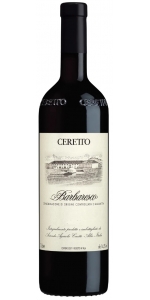Wine from Ceretto
The quest of the brothers Bruno and Marcello Ceretto was to select vineyards in the most valuable positions historically. This idea came about during a trip to Burgundy, and would prove the family’s insight and see their Barolo and Barbaresco wines among the most popular in the world. A revolution at the time, for a territory in which the concept of cru was totally unknown, but, above all, a brilliant idea. The most difficult challenge the brothers faced was convincing their father who, as was typical at the time, purchased grapes for the wines he vinified. You are undertaking a difficult journey, the land has never made anybody rich, he warned, but Bruno and Marcello were convinced about the potential of the land and stubbornly replied, We believe in the land 100%, the winery is obviously important, but great wines are made with great grapes. And so, they began dreaming of labels bearing the name of the vineyard and also its image: so whoever drinks that wine can see the vineyard from which it has originated. The vineyard is history, the names of the hills remain, unchanged over time, enhancing the quality and credibility of the wines produced here. You can search out, visit and physically touch a vineyard… always. In 1986, Wine Spectator, perhaps the most influential American magazine in the world of wine, puts the two Langhe brothers on the cover calling them the Barolo Brothers. Bruno and Marcello were less than 50 years old, but they were not overwhelmed by what was an official consecration, to which all aspire, but few can obtain. Even today, they have remained true to themselves, they have not stopped dreaming and fighting for their righteous goal. Meanwhile, the Langa has grown with them and with those who, like them, puts their name to the land where they were born and accompanied them throughout their lives.
Ceretto Barbaresco DOCG is made from 100 percent Nebbiolo.
If we could sum this wine up in a single word, we wouldn’t hesitate to define it as “classic”. As tradition suggests, this Barbaresco is the fruit of the assembly of several parcels of land, coming from some of our most beautiful vineyards. The idea is that of naturally obtaining balance by harmonizing different expressions, often contrasting ones. The result is a liquid expression of a terroir, tempting and typical, a synopsis of one Langa, that of Barbaresco, which moves in the glass, alternating between structure and elegance.
Review:
Very aromatic with orange blossom, roses and iron. Medium-bodied with very fine tannins. Refined and beautiful. Drink now or hold.
-James Suckling 93 Points
- back
Selected Options
Wineries
Categories
Pricing
Countries
Regions
Grape Types
Wineries
Organic/Free Shipping
The Prisoner Wine Company Sonoma Coast Pinot Noir is made from 100 percent Pinot Noir.
From the most recognized Napa Valley red blend comes a bold, new wine. Made in the same iconic style as The Prisoner Red Blend, we proudly introduce The Prisoner Pinot Noir. Redefining taste once again.
A mix of Russian River and Carneros AVAs produces this classic Sonoma Coast Pinot Noir with notes of ripe cranberry, pomegranate, and cherry with clove spice. The palate is driven by rhubarb and cherry with an underlying minerality and spice, which culminates with soft tannins and an elegant, balanced acidity.
Chef Brett recommends pairing The Prisoner Pinot Noir with Mushroom Risotto or Grilled Salmon.
Post & Beam by Far Niente Sonoma Coast Pinot Noir is made from 100% Pinot Noir.
Post & Beam Pinot Noir, crafted with the same care and expertise that defines Far Niente Wine Estates, is sourced from the Sonoma Coast's cool, coastal vineyards. This wine offers vibrant acidity, expressive fruit, and nuanced complexity, with aromas of ripe red fruit and a hint of spice. The smooth, balanced palate finishes with elegance, making it perfect for backyard get-togethers.





